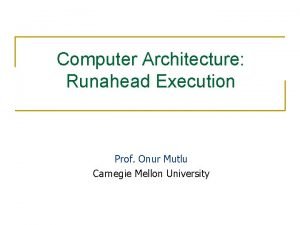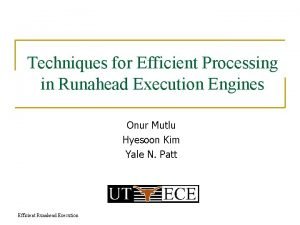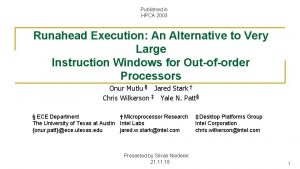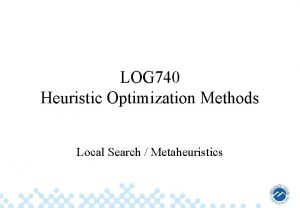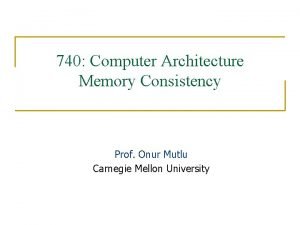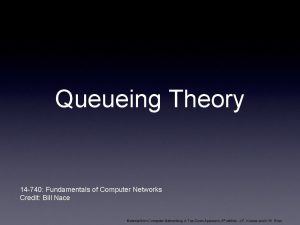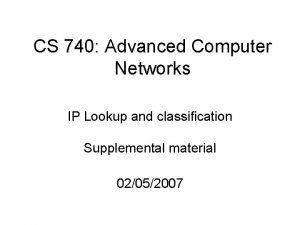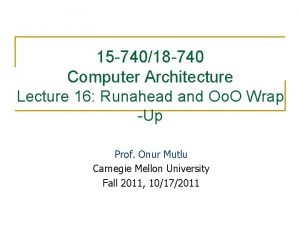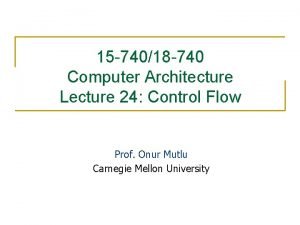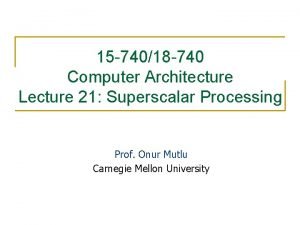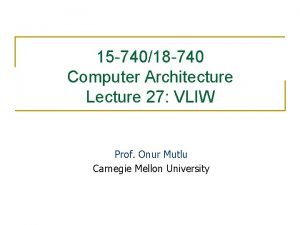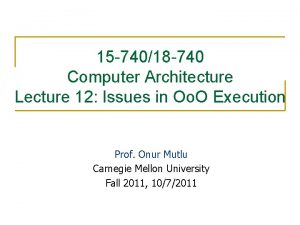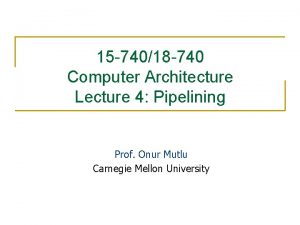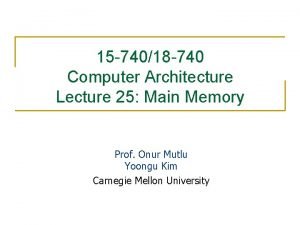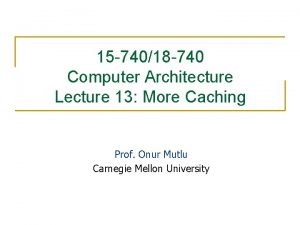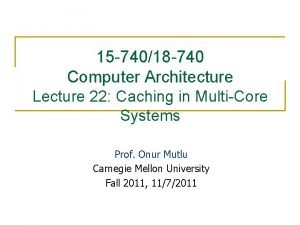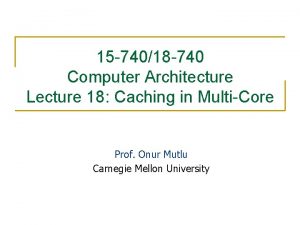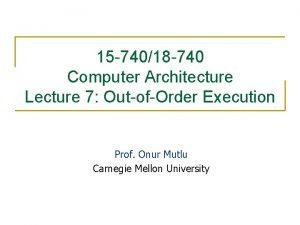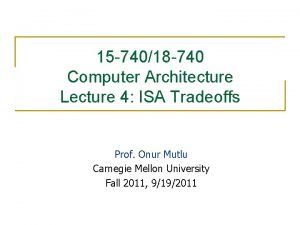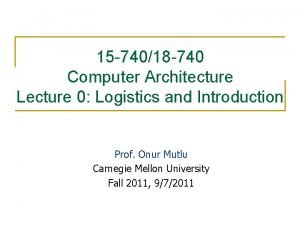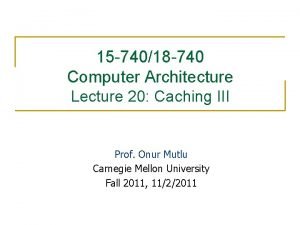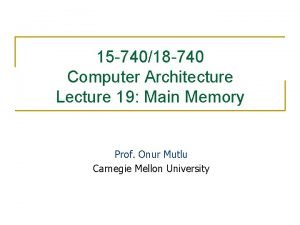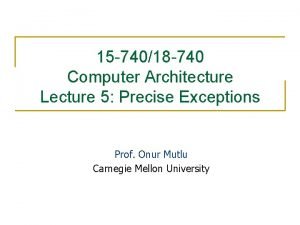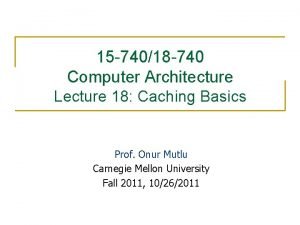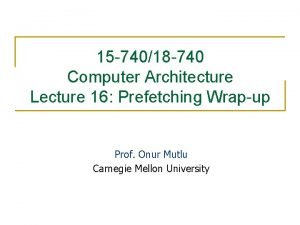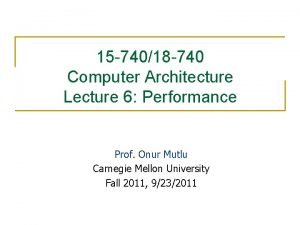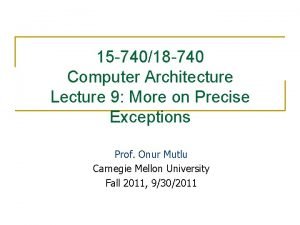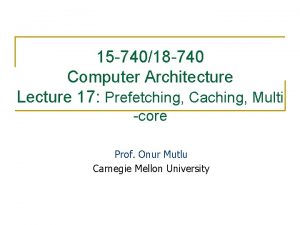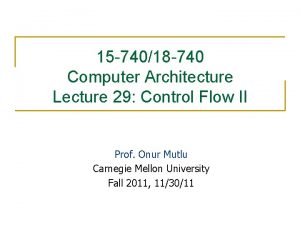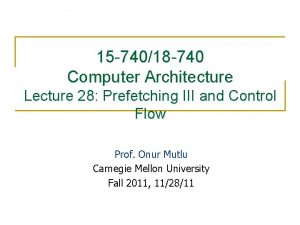15 74018 740 Computer Architecture Lecture 16 Runahead
















![Review: Memory Latency Tolerance Techniques n n Caching [initially by Wilkes, 1965] q Widely Review: Memory Latency Tolerance Techniques n n Caching [initially by Wilkes, 1965] q Widely](https://slidetodoc.com/presentation_image_h2/7cb4226196d623aa039b233c12c9fd95/image-17.jpg)















- Slides: 32

15 -740/18 -740 Computer Architecture Lecture 16: Runahead and Oo. O Wrap -Up Prof. Onur Mutlu Carnegie Mellon University Fall 2011, 10/17/2011

Review Set 9 n Due this Wednesday (October 19) q q n Wilkes, “Slave Memories and Dynamic Storage Allocation, ” IEEE Trans. On Electronic Computers, 1965. Jouppi, “Improving Direct-Mapped Cache Performance by the Addition of a Small Fully-Associative Cache and Prefetch Buffers, ” ISCA 1990. Recommended: q q q Hennessy and Patterson, Appendix C. 2 and C. 3 Liptay, “Structural aspects of the System/360 Model 85 II: the cache, ” IBM Systems Journal, 1968. Qureshi et al. , “A Case for MLP-Aware Cache Replacement, “ ISCA 2006. 2

Announcements n Midterm I next Monday q n Exam Review q n Likely this Friday during class time (October 21) Extra Office Hours q n October 24 During the weekend – check with the TAs Milestone II q Is postponed. Stay tuned. 3

Course Feedback Analysis (I) n 24 responses, 26 registered n Course Pace: q q n Slow: 2 Right: 17 Fast: 4 Too fast: 1 Lecture pace: q q q Slow: 5 Right: 15 Fast: 4 4

Course Feedback Analysis (II) n Material difficulty: q q n Easy: 2 Right: 17 Hard: 4 Depends: 1 Workload: q q q Right: 5 Heavy: 6. 5 Too heavy: 9 5

Course Pace Comments n Fast pace allows the amount of material I would like to see covered. 6

Lecture Pace Comments n n n Tangential discussions make lectures worth coming to instead of just having a rehash of slides Fast, but understandable Good that some key concepts are repeated twice 7

Material Difficulty Comments n n n Depends on background. Coming from a different university, it is apparent some material is more familiar to those who took comp arch at CMU Lectures OK, some papers hard Started out with zero knowledge and have understood all concepts 8

Workload Comments n n n Reviews take longer than homeworks ++ Paper reviews are too intense Just the right amount 9

What to Change Comments? n n n Start and finish on time ++ Have what you write on board in the slides; have written lecture notes (latex’ed) +++++ Reviews q q q n n Require only half the readings, let us choose the rest No paper reviews (or no homeworks, not both) Difficult to write reviews for overview papers Fewer paper reviews ++ Time consuming More homeworks +++ Some older papers are dry (and you cover them anyway) Fast feedback on homeworks +++ Decrease % of exams on grade 10

What to Change Comments? n Lectures q q n n n Two lectures a week +++ Add a recitation per week Simulator doesn’t have documentation +++ Include video lectures Course expectations high; I feel this is expected of students; nothing to change Provide estimates on how long we should be spending on the parts of the course Some questions on slides are unanswered 11

Other Comments n n n n A lot of other classes overlook classroom interaction; not this one Sometimes it is hard to hear questions and question is not repeated Go more in depth into topics The amount of work exceeds what I would expect from a 12 unit course ++ Please don’t murder me with the exam Lectures make sense even w/o comp arch background I am learning a lot. Very interesting. Write a textbook! 12

Action on Course Feedback n Will have fewer lectures toward the end of the course q To enable you to focus on projects n Will try to start and finish on time n Will take into account other feedback as I described n Will not murder you on the exam q Assuming you understand the material! 13

Last Lecture n n Limitations of baseline runahead execution mechanism Memory-level parallelism Memory latency tolerance techniques Runahead execution performance q n n vs. Large instruction windows Limitations of baseline runahead execution Wrong path events Causes of inefficiency in runahead execution Address-value delta (AVD) prediction 14

Today n n n Dual-core execution Load store handling in out-of-order versus runahead execution Research issues in out-of-order execution or latency tolerance Accelerated critical sections Caching, potentially 15

Review: Memory Level Parallelism (MLP) n Idea: Find and service multiple cache misses in parallel n Why generate multiple misses? parallel miss isolated miss A B C time q n Enables latency tolerance: overlaps latency of different misses How to generate multiple misses? q Out-of-order execution, multithreading, runahead, prefetching 16
![Review Memory Latency Tolerance Techniques n n Caching initially by Wilkes 1965 q Widely Review: Memory Latency Tolerance Techniques n n Caching [initially by Wilkes, 1965] q Widely](https://slidetodoc.com/presentation_image_h2/7cb4226196d623aa039b233c12c9fd95/image-17.jpg)
Review: Memory Latency Tolerance Techniques n n Caching [initially by Wilkes, 1965] q Widely used, simple, effective, but inefficient, passive q Not all applications/phases exhibit temporal or spatial locality Prefetching [initially in IBM 360/91, 1967] q Works well for regular memory access patterns q Prefetching irregular access patterns is difficult, inaccurate, and hardwareintensive Multithreading [initially in CDC 6600, 1964] q Works well if there are multiple threads q Improving single thread performance using multithreading hardware is an ongoing research effort Out-of-order execution [initially by Tomasulo, 1967] q Tolerates cache misses that cannot be prefetched q Requires extensive hardware resources for tolerating long latencies 17

Review: Limitations of the Baseline Runahead Mechanism n Energy Inefficiency q q n Ineffectiveness for pointer-intensive applications q q n A large number of instructions are speculatively executed Efficient Runahead Execution [ISCA’ 05, IEEE Micro Top Picks’ 06] Runahead cannot parallelize dependent L 2 cache misses Address-Value Delta (AVD) Prediction [MICRO’ 05, IEEE TC’ 06] Irresolvable branch mispredictions in runahead mode q q Cannot recover from a mispredicted L 2 -miss dependent branch Wrong Path Events [MICRO’ 04]

Other Limitations of Runahead n n What are the best instructions to execute during runahead mode? When to end runahead mode? What if the L 2 misses are far apart from each other? 19

Dual Core Execution n n Idea: One thread context speculatively runs ahead on load misses and prefetches data for another thread context Zhou, “Dual-Core Execution: Building a Highly Scalable Single- Thread Instruction Window, ” PACT 2005. 20

Dual Core Execution n The front processor runs faster by invalidating long-latency cache -missing loads, similar to runahead execution q q n Load misses and their dependents are invalidated Branch mispredictions dependent on cache misses cannot be resolved Highly accurate execution as independent operations are not affected q q Accurate prefetches to warm up caches Correctly resolved independent branch mispredictions 21

Dual Core Execution n Re-execution ensures correctness and provides precise program state q n Resolve branch mispredictions dependent on long-latency cache misses Back processor makes faster progress with help from the front processor q q Highly accurate instruction stream Warmed up data caches 22

Runahead and Dual Core Execution n Runahead execution: + Approximates the MLP benefits of a large instruction window (no stalling on L 2 misses) -- Window size limited by L 2 miss latency (runahead ends on miss return) n Dual-core execution: + Window size is not limited by L 2 miss latency -- Multiple cores used to execute the application; long misprediction penalty Easier to scale (FIFO) n Zhou, Dual-Core Execution: “Building a Highly Scalable Single-Thread Instruction Window, ” PACT 2005. 23

Runahead and Dual Core Execution Runahead: Load 1 Miss Compute Load 2 Miss Load 1 Hit Runahead Load 2 Hit Compute Runahead Saved Cycles Miss 1 Miss 2 Load 3 Miss DCE: front processor Load 1 Miss Load 2 Miss Load 3 Miss Compute Miss 1 Miss 2 Miss 3 DCE: back processor Load 1 Miss Compute Stall Load 2 Hit Load 3 Hit Compute Saved Cycles 24

Handling of Store-Load A load’s dependence status is not known until all previous store Dependencies n addresses are available. n n How does the OOO engine detect dependence of a load instruction on a previous store? q Option 1: Wait until all previous stores committed (no need to check) q Option 2: Keep a list of pending stores in a store buffer and check whether load address matches a previous store address How does the OOO engine treat the scheduling of a load instruction wrt previous stores? q Option 1: Assume load independent of all previous stores q Option 2: Assume load dependent on all previous stores q Option 3: Predict the dependence of a load on an outstanding store 25

Store Buffer Design (I) n An age ordered list of pending stores q n Two purposes: q q n Dependency detection Data forwarding (to dependent loads) Each entry contains q n un-committed as well as committed but not yet propoagated into the memory hierarchy Store address, store data, valid bits for address and data, store size A scheduled load checks whether or not its address overlaps with a previous store 26

Store Buffer Design (II) n n Why is it complex to design a store buffer? Content associative, age-ordered, range search on an address range q Check for overlap of [load EA, load EA + load size] and [store EA, store EA + store size] n n EA: effective address A key limiter of instruction window scalability q Simplifying store buffer design or alternative designs an important topic of research 27

Memory Disambiguation (I) n Option 1: Assume load independent of all previous stores + Simple and can be common case: no delay for independent loads -- Requires recovery and re-execution of load and dependents on misprediction n Option 2: Assume load dependent on all previous stores + No need for recovery -- Too conservative: delays independent loads unnecessarily n Option 3: Predict the dependence of a load on an outstanding store + More accurate. Load store dependencies persist over time -- Still requires recovery/re-execution on misprediction q q q Alpha 21264 : Initially assume load independent, delay loads found to be dependent Moshovos et al. , “Dynamic speculation and synchronization of data dependences, ” ISCA 1997. Chrysos and Emer, “Memory Dependence Prediction Using Store Sets, ” ISCA 1998. 28

Memory Disambiguation (II) n n n Chrysos and Emer, “Memory Dependence Prediction Using Store Sets, ” ISCA 1998. Predicting store-load dependencies important for performance Simple predictors (based on past history) can achieve most of the potential performance 29

Speculative Execution and Data Coherence n Speculatively executed loads can load a stale value in a multiprocessor system q n The same address can be written by another processor before the load is committed load and its dependents can use the wrong value Solutions: 1. A store from another processor invalidates a load that loaded the same address -- Stores of another processor check the load buffer -- How to handle dependent instructions? They are also invalidated. 2. All loads re-executed at the time of retirement 30

Open Research Issues in OOO Execution (I) n Performance with simplicity and energy-efficiency n How to build scalable and energy-efficient instruction windows q q n How to approximate the benefits of a large window q q n To tolerate very long memory latencies and to expose more memory level parallelism Problems: n How to scale or avoid scaling register files, store buffers n How to supply useful instructions into a large window in the presence of branches MLP benefits vs. ILP benefits Can the compiler pack more misses (MLP) into a smaller window? How to approximate the benefits of OOO with in-order + enhancements 31

Open Research Issues in OOO Execution (II) n OOO in the presence of multi-core n More problems: Memory system contention becomes a lot more significant with multi-core q q n More opportunity: Can we utilize multiple cores to perform more scalable OOO execution? q n OOO execution can overcome extra latencies due to contention How to preserve the benefits (e. g. MLP) of OOO in a multi-core system? Improve single-thread performance using multiple cores Asymmetric multi-cores (ACMP): What should different cores look like in a multi-core system? q OOO essential to execute serial code portions 32
 Runahead execution
Runahead execution Runahead execution
Runahead execution Runahead execution
Runahead execution Computer architecture lecture notes
Computer architecture lecture notes Isa definition computer
Isa definition computer Asc 740
Asc 740 Difference between fas 109 and asc 740
Difference between fas 109 and asc 740 Outside basis difference
Outside basis difference 740
740 Gabriel deloitte
Gabriel deloitte Onur mutlu computer architecture
Onur mutlu computer architecture Public law 740 passed by congress
Public law 740 passed by congress 14-740
14-740 F 740
F 740 R 740
R 740 Cs 740
Cs 740 01:640:244 lecture notes - lecture 15: plat, idah, farad
01:640:244 lecture notes - lecture 15: plat, idah, farad Bus design in computer architecture
Bus design in computer architecture Difference computer organization and architecture
Difference computer organization and architecture Design of a basic computer
Design of a basic computer Computer security 161 cryptocurrency lecture
Computer security 161 cryptocurrency lecture Computer-aided drug design lecture notes
Computer-aided drug design lecture notes Abc in software architecture
Abc in software architecture Data centered architecture
Data centered architecture Product architecture design
Product architecture design Product architecture
Product architecture Computer organization and architecture 10th solution
Computer organization and architecture 10th solution Computer architecture 101
Computer architecture 101 Virtual labs iit kharagpur
Virtual labs iit kharagpur Introduction to computer organization and architecture
Introduction to computer organization and architecture Timing and control in computer architecture
Timing and control in computer architecture Computer architecture: concepts and evolution
Computer architecture: concepts and evolution Programmed i/o in computer architecture
Programmed i/o in computer architecture
